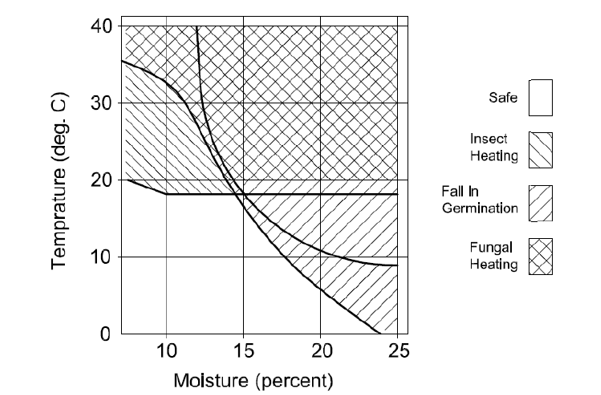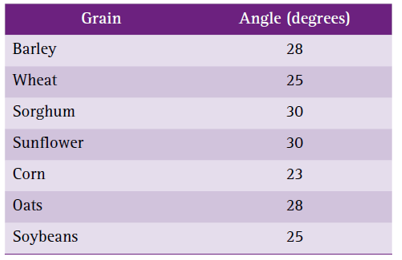Grains can be divided into three groups: cereals (maize, wheat, barley, sorghum, rice); pulses (lupins, beans, peas); and oilseeds (soybeans, sunflower, linseed, canola).
 |
 |
 |
Click here to view a video that explains storing pulses.
Different grains and grain types have a range of characteristics that can affect the type of distribution system selected and the components required in the distribution system. These characteristics include moisture content, weight of the grains, angle of repose of the grains, abrasion of the grains against contact surfaces and ease of flow of the grains. A brief description of moisture content and angle of repose follows.
Moisture Content
Moisture content in grain is defined as the amount of water that is absorbed into the grain kernel as a percentage of the total weight of the grain kernel.
The moisture content of a grain is typically provided on a ‘wet basis’ (wb) and is calculated as:

Standard grain grades with moisture contents of 13–18% do not usually cause material flow problems. But high moisture content grain, when coupled with high foreign material contents and fines, can lead to material flow and handling problems. Moisture content of the grain can change with the environment in which it is stored and this should be monitored to help ensure the overall condition of the grain.
The Figure below illustrates the potential issues with stored grain at a range of temperatures and moisture contents. As the temperature rises, the safe level of moisture in the grain must be reduced for good quality storage.
Figure below: Effects in storage at different temperatures and moisture content.

Angle of Repose
The angle of repose is the greatest angle from the horizontal to which a grain can be raised without it sliding or rolling on itself in an unconsolidated form. This determines whether a grain mass will flow by gravity or need outside forces to move. It will determine the minimum spouting angles for gravity flow. The angle of repose of grains varies with type, variety, moisture content, quality and level of contamination.
Angle of Repose for common grains is shown in Table below. These angles will increase for wet grain and may also vary slightly depending on grain quality and its admixture content. The grain coefficients can be used for calculating volume of grain when piled at a natural angle of repose.
Table below. Angle of repose for common grains

Abrasion
All grains will wear the surfaces that are in contact with flow. The amount of wear will vary according to the type of grain, the volume of grain, speed of grain, the impact of grain streams on surfaces and the slope of the contact surface. All aspects of the distribution system are affected by these characteristics. When analysing systems, components such as spouting, transitions, gates, valves, conveyors and future access to these components must be designed into the system for maintenance requirements.

Corrosion
Wet grains, ground-processed grains, and chemically-treated grains can corrode standard carbon steel fabrications. Each grain type to be handled must be checked to determine if stainless steel is needed or will reduce possible life cycle costs. If water wash-down, or cleaning-place systems are required, materials used for fabrication in the distribution system should be considered.
All storage systems must be designed to adequately protect and preserve the quality of the grain. Whole grain can sprout under certain conditions and will also attract moulds, insects and rodents. In addition, the storage of grain presents several safety issues which needs to be provided for.